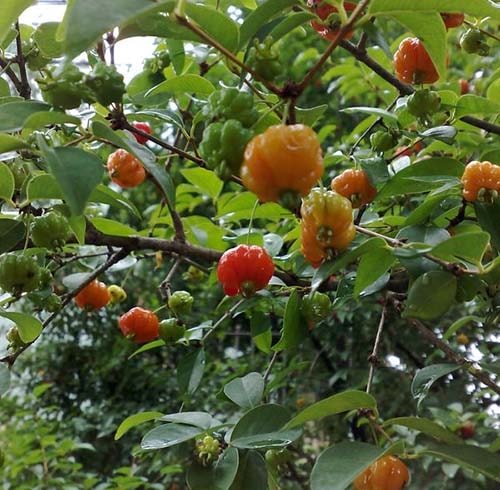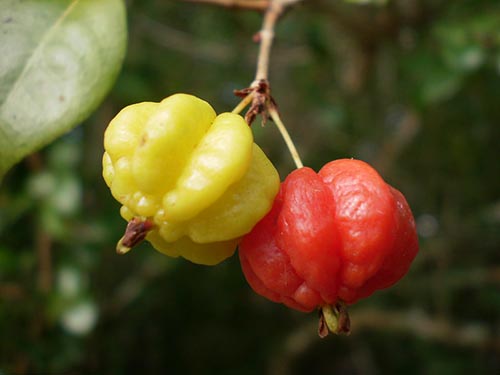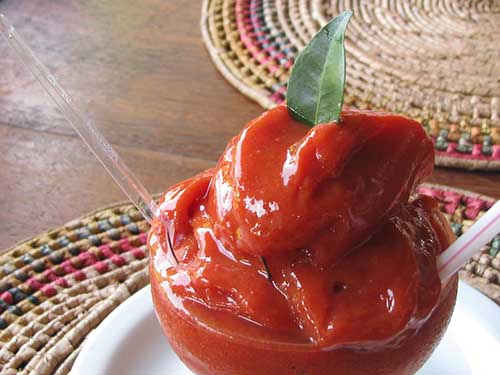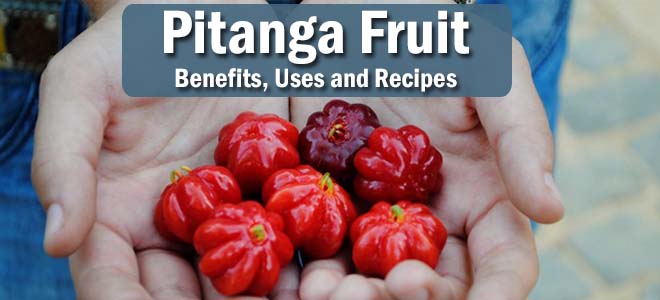A while back, I spent a several months living in the Amazon regions of Brazil and Peru. Aside from the astounding natural beauty and culture of the region, it was also one of the best culinary experiences of my life. I discovered dozens of foods I had never heard of before – including the pitanga fruit.
What Is Pitanga?

Also known as Surinam cherry (despite not being related to cherries at all), pitanga is a large shrub that produces lots of small red fruits. The fruits have a very distinct shape which kind of reminds me of a pumpkin.
Pitanga is native to Surinam and Brazil’s rain forests. Because the plant is hardy, resistant to pests and grows easily, it has also been introduced in places like South Africa, Jamaica, Java, Florida, Haiwaii, and throughout South and Central America.
Unless you travel to one of the places pitanga grows, it’s unlikely that you’ll be able to find it fresh anywhere. The fruits are really delicate and start to go bad quickly, so it can’t be shipped internationally. However, it is sometimes possible to find pitanga products, especially ones made out of pitanga seed oil for skin and hair.
Recommended:
Teadora Superfruits Skin Cleanser with Pitanga Oil
- Revitalizes skin
- Sustainably sourced and vegan
- High in antioxidants
- Contains superfuits which are great for skin health
- Buy here
Linha Brazilian Fruits Skin Balm
- Contains pitanga oil and other skin-nourishing plant oils
- Good for skin repair
- Buy here
Linha Shower Oil with Pitanga Oil
- Incredibly nourishing for skin
- Antimicrobial properties of pitanga help eliminate body odor
- Also contains African palm oil
- Buy here
Other Names for Pitanga
- Eugenia uniflora (Latin)
- Surinam cherry
- Brazil cherry
- Florida cherry
- Cayenne cherry
- Pitangueira
- “Nature’s most generous fruit”
- Ñangapirí
- Dereza de Cayena
- Cerise de cayenne
- Monkimonki kersie
Health Benefits of Pitanga
Pitanga fruit, leaves and bark have been used for centuries in Brazil medicinally. It is well-known with locals who recommend it for treating ailments ranging from colds and flu to high blood pressure. More recently, scientists became more interested in pitanga. Starting around 2000, you can see the number of studies on pitanga health benefits increasing almost every year.

Below are just some of the main health benefits of pitanga.
Skin and Hair
Essential oil from pitanga leaves is found in many beauty products. It is applied to skin to prevent wrinkles and to hair to rejuvenate it. While there is little scientific evidence that pitanga gets rid of wrinkles, the high levels of antioxidants and hydroxy acids in pitanga could help tighten skin. Sesquiterpenes compounds in pitanga help calm the skin and repair cellular damage. Much like aguaje and mongongo oil, the antioxidants and anti-microbial properties of pitanga oil also could help treat acne.
Anti-Viral, Antibateria and Anti-Fungal
One of the main health benefits of pitanga is in fighting infections, including viruses, bacteria and fungal infections.
Numerous studies show that pitanga essential oils have natural anti-microbial properties. The oil effectively inhibited bacteria including Staphylococcus aureus, Listeria monocytogenes, Streptococcus and E. coli as well as Candida fungi and viruses like Dengue and malaria. (Sources: 1, 2, 3, 4, 5)
Antioxidants
All parts of the pitanga plant are high in numerous antioxidants including anthocyanin, beta carotene, phenolic compounds, lycopene, and flavonoids (to name a few). These potent antioxidants are responsible for many of the health benefits of pitanga, including:
- Fighting cancer
- Treating gout
- Better immune health
- Preventing and treating diabetes
- Anti-inflammatory
- Gut health
Hypertension
Pitanga is a natural treatment for high blood pressure. It helps by dilating blood vessels as well as acting as a mild diuretic to improve blood flow. (9)
How Is Pitanga Used?
Pitanga fruit is often eaten fresh or made into juice, jellies, pickles, salsas, desserts or even cocktails. For medicinal benefits though, it’s usually the leaves and seeds of pitanga which are used; the essential oils are extracted and then taken internally or applied to the skin. Sometimes pitanga leaves are consumed as tea. It’s also common to find pitanga essential oils in soaps and beauty products.
What Does Pitanga Taste Like?

Pitanga fruit has a very unique flavor. It is sweet, bitter and acidic all at the same time. There is also a slightly peppery taste to pitanga, similar to that of red bell peppers. The riper the fruit becomes, the less acidic and tart it is.
The first time I tried pitanga (straight from the shrub), I really disliked it. My host laughed at me and showed me how to make pitanga taste better.
- First cut the pitanga fruit and take out the seed
- Open up the fruit, sprinkle it with sugar, and put it in the fridge for an hour or two
- This apparently lets the tannins “air out” so the bitter taste goes away
- Then eat the fruit raw or use it in a recipe
Pitanga Recipes

If you are lucky enough to have fresh pitanga near you, try these recipes. I personally love it as a salsa/relish to use over rice dishes. Enjoy!
- Jam from pitanga
- Mousse from pitanga
- Pitanga sambal (Indonesian chili sauce)
- Pitanga relish
- Caipirinha with pitanga (Portuguese)
- Coconut pudding with pitanga sauce (Portuguese)
- Cookies with pitanga jam (Portuguese)
Do you use pitanga? Let us know how in the comments section below.





I just discovered I had the tree all this time, it bare fruits twice but this year I noticed and wow, I am so happy I had the leaves for tea, and ate the fruits…thank goodness my hubby did not cut it down
It’s funny how many superfood plants are around us but we don’t even realize it.
Hello, how do you make a tea from the piranha leaves. Ewa
Pitanga
Honestly I have pitanga flowers in my house for many years but I was ignorant of the health benefits and the nutritional value of this wonderful plant
Anytime I go round my garden I am naturally attracted to this flower by the beautiful aroma from the leaves,though the children around rush to pick the pumpkin like fruits.
I knew the fruits are edible,but I had no information about the leaves, untill I decided to google the health benefits of pitanga and I was astonished about my discovery of this shrub health and nutritional benefits.
I have since drank pitanga leaf tea on several occasions to adequately manage ulcer pain and diarrhea.
At each occasions my stool had shown much improvement on shape and integrity coming out cylindrical like a sausage 🌭
The leaf tea was able to control occasional cough and I noticed improved early morning strength anytime I consume pitanga fruits or tea.
I am happy to have this flower abundantly in my premises tI am begining to start my documentation on the phytomedicinal and neutraceatical values of pitanga in humans and veterinary practices